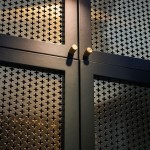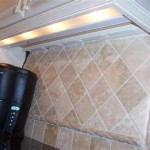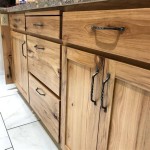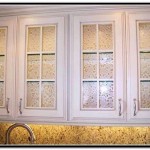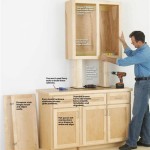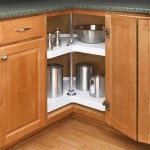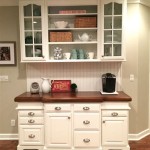Refinish Kitchen Cabinets Without Sanding: A Comprehensive Guide
Refinishing kitchen cabinets presents a significant opportunity to revitalize the heart of a home without incurring the substantial costs associated with a complete replacement. While traditional cabinet refinishing often involves extensive sanding to prepare the surfaces for paint or stain, alternative methods exist that minimize or eliminate the need for this labor-intensive step. This approach can save considerable time and effort, making it an attractive option for homeowners seeking a more streamlined renovation process.
The elimination of sanding reduces the amount of dust generated, contributing to a cleaner and healthier working environment. Further, it can be particularly beneficial for cabinets with intricate details or delicate veneers, where sanding might risk damaging the existing finish. This method relies heavily on chemical cleaners and bonding primers to ensure proper adhesion of the new finish, making the selection of appropriate products crucial for the success and longevity of the refinishing project.
Understanding the Benefits of Sandless Cabinet Refinishing
Sandless cabinet refinishing offers several advantages over traditional methods. The most obvious benefit is the reduction in labor and associated time savings. Sanding cabinets, especially those with multiple doors and drawers, can be a time-consuming and physically demanding task. Eliminating this step allows for a faster turnaround time, minimizing disruption to the kitchen's functionality. Sanding can also damage the structure of some cabinets, this method can preserve the structural integrity of these cabinets.
Dust control is another significant advantage. Sanding generates a considerable amount of dust, which can be difficult to contain and clean up. This dust can also pose a health hazard, especially for individuals with respiratory sensitivities. By eliminating sanding, the project becomes cleaner and safer. This becomes particularly important in occupied homes where complete isolation of the work area is not always feasible. Protecting existing appliances and surrounding surfaces from dust contamination is also less challenging.
Finally, certain cabinets, particularly those with thin veneers or intricate decorative elements, are susceptible to damage from sanding. Aggressive sanding can easily penetrate the veneer layer or damage delicate carvings, resulting in irreversible damage. Sandless refinishing techniques offer a gentler approach, preserving the original details and integrity of the cabinets. This is particularly important for antique or high-value cabinets where preserving their original features is a priority.
Essential Materials and Tools for Sandless Refinishing
Successful sandless cabinet refinishing requires a careful selection of materials and tools. The foundation of this approach lies in the use of effective cleaning agents and high-quality bonding primers that promote adhesion without the need for a mechanically abraded surface. In addition to these core materials, several other tools are essential for achieving a professional-looking finish.
A degreaser is crucial for removing grease, grime, and other contaminants that can interfere with paint adhesion. Trisodium phosphate (TSP) is a commonly used option, but safer alternatives are readily available. A scrub brush or sponge is necessary for applying the degreaser and thoroughly cleaning the cabinet surfaces. Multiple clean cloths will be needed to wipe away the cleaning solution and dry the cabinets thoroughly.
A liquid deglosser prepares the surface by dulling the existing finish, which will help the primer adhere better. This chemical process is less aggressive than sanding. It is crucial to follow the manufacturer's instructions carefully when using a deglosser, ensuring proper ventilation and wearing appropriate protective gear, such as gloves and eye protection. Choose a deglosser that is compatible with the existing cabinet finish and the intended primer and paint. The surface need only be wiped; no scrubbing is required.
A high-quality bonding primer is the key to ensuring proper adhesion of the new finish. These primers are specifically formulated to adhere to glossy surfaces without sanding. Choose a primer that is compatible with the type of paint or stain that would be top coated. Consider using a stain-blocking primer to prevent bleed-through from the existing finish, especially if the cabinets are stained with a dark color. The primer should be applied evenly and allowed to dry completely according to the manufacturer's instructions.
High-quality paint or stain is the final step in the refinishing process. Select a durable and washable paint or stain that is appropriate for kitchen cabinets. Consider using a paint specifically formulated for cabinets and trim, as these paints typically offer better resistance to scratches and stains. A smooth, even application is crucial for achieving a professional-looking finish. Use a high-quality brush, roller, or sprayer to apply the paint or stain. Multiple thin coats are preferable to a single thick coat, as this will minimize drips and ensure even coverage.
Additional tools that may be needed include a screwdriver for removing cabinet doors and hardware, painter's tape for masking off areas that should not be painted, drop cloths to protect flooring and countertops, and sandpaper (for minor touch-ups or smoothing out imperfections), and safety glasses and gloves to protect the eyes and skin.
Step-by-Step Guide to Sandless Cabinet Refinishing
The process of refinishing kitchen cabinets without sanding involves a series of carefully executed steps, from thorough preparation to the final application of the chosen finish. Adhering to these steps will significantly increase the likelihood of achieving a durable and aesthetically pleasing result.
Begin by removing all cabinet doors, drawers, and hardware. This will allow for easier access to all surfaces and ensure a more professional finish. Label each door and drawer with its corresponding location in the kitchen to facilitate reinstallation. Thoroughly clean the cabinet doors, drawers, and frames with a degreasing cleaner. Remove all grease, grime, and other contaminants that could interfere with primer and paint adhesion. Rinse the surfaces with clean water and allow them to dry completely. Mildew or mold should be treated with bleach or a mold remover.
Apply a liquid deglosser to the cabinet surfaces according to the manufacturer's instructions. This will dull the existing finish and create a better surface for the primer to adhere to. Ensure proper ventilation and wear appropriate protective gear during this step.
Apply a high-quality bonding primer to all cabinet surfaces. Use a brush or roller to apply the primer evenly, paying attention to corners and edges. Allow the primer to dry completely according to the manufacturer's instructions. If the existing finish is heavily stained or varnished, apply a second coat of primer for optimal adhesion and stain blocking. Lightly sand any imperfections or drips in the primer with fine-grit sandpaper. Wipe away any sanding dust with a clean cloth.
Apply the chosen paint or stain to the cabinet surfaces. Use a high-quality brush, roller, or sprayer to apply the paint or stain evenly. Apply multiple thin coats, allowing each coat to dry completely before applying the next. This will ensure even coverage and minimize drips. Lightly sand any imperfections or drips in the paint or stain with fine-grit sandpaper. Wipe away any sanding dust with a clean cloth.
Once the paint or stain is completely dry, reinstall the hardware, doors, and drawers. Take care to align the doors and drawers properly. Touch up any areas that may have been scratched or damaged during reinstallation.
Allow the paint or stain to cure completely before using the cabinets. This may take several days, depending on the type of paint or stain used. Clean the cabinets regularly with a mild detergent and water to maintain their appearance. Avoid using harsh chemicals or abrasive cleaners, as these can damage the finish.

How To Paint Kitchen Cabinets Without Sanding Sustain My Craft Habit

Can You Paint Kitchen Cabinets Without Sanding

How To Paint Kitchen Cabinets Without Sanding The Budget Decorator

How To Paint Cabinets Without Sanding

How To Paint Cabinets Without Sanding A Fresh Squeezed Life

How To Paint Kitchen Cabinets Without Sanding Sustain My Craft Habit

How To Paint Kitchen Cabinets White Without Sanding Painting Old

Painting Over Oak Cabinets Without Sanding Or Priming Hometalk

Can You Paint Cabinets Without Sanding Trusted Coatings

Paint Kitchen Cabinets Without Sanding Six Simple Steps
Related Posts

